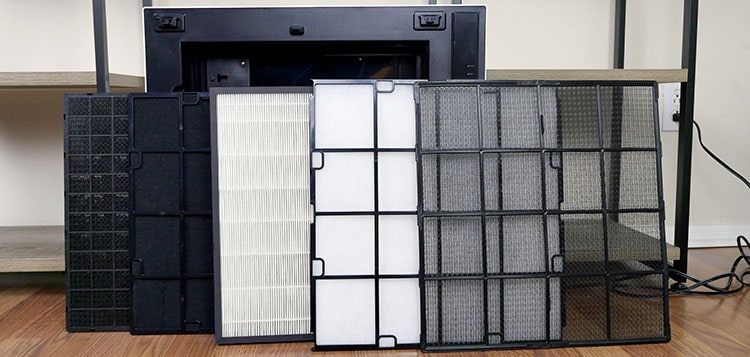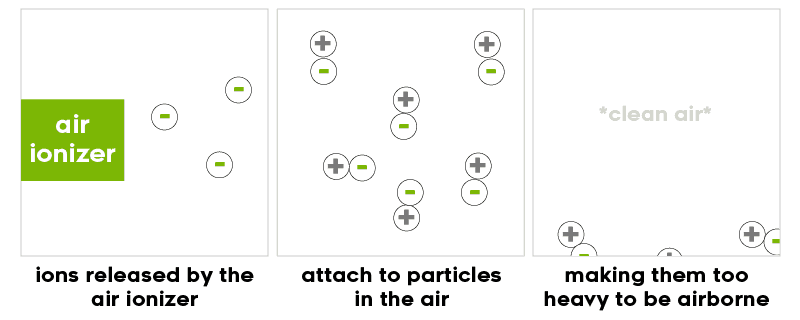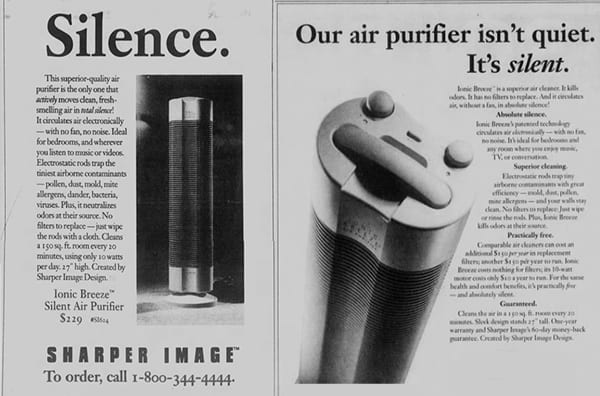Air ionizers are designed to help provide cleaner air and they do this by utilizing ionized particles. But a lot of questions tend to come with the use of air ionizers, one of the most common being…Are air ionizers dangerous?
The Short Answer: It depends on who you ask. Some critics believe that air ionizers give off dangerous levels of ozone which is not only harmful to the environment, but can be equally as hazardous to your health.

When inhaled in high enough doses, ozone can have harmful effects– including damage to your lungs, chest pain, coughing, or shortness of breath.
Because of this concern, federally-mandated standards restrict the amount of ozone any air purifier can give off. These restrictions help to ensure that any potential ozone exposure remains at a safe level.
Air ionizers vs. Ionic air purifiers
First things first, let’s get our names straight. In the air purifier market, there are air ionizers and there are ionic air purifiers.

What’s the difference?
Basically nothing.
These are two different ways to talk about the same technology, electrically charged molecules being used to help purify the air. In this guide, we’ll be calling them air ionizers– so let’s continue.
How do air ionizers work?
A typical air purifier would use fans or filters to help remove contaminants and purify the air. In the case of air ionizers, they rely on the use of electrically charged air molecules, or ions, to do the same job.
RELATED – See our full list of air purifier reviews.
Every room is filled with positively charged particles, which could be made up of dust, microbes, odors, airborne bacteria or illnesses, smoke or other allergens.
The job of an air ionizer is to release negatively charged particles that are then attracted and bond to the positively charged particles in the room.

When the ionized particles bond to the airborne particles, the joint union is then too heavy to float in the air and they fall to the ground. Once they’re no longer airborne, these particles can be vacuumed up, or dusted off of furniture and raised surfaces.
What are the benefits of air ionizers?
Negative ions produce a number of benefits in our natural environment.
Think of some of your favorite places. Maybe it’s the ocean, a serene waterfall or out in nature’s greenery.

This short list here includes some of the natural environments with the highest levels of detected negative ions present
Air ionizers and their connection to negative ions can mean big benefits to your respiratory system and overall health. The use of negative ions in the air can have the following results:
- Improved air quality through the removal of dust, allergens, pollen, pet dander, mold spores and other airborne bacteria.
- Decreased exposure to airborne respiratory bacteria like colds, flu, and asthmatic triggers
- Improved sleep and overall mood, according to a 2012 Italian study that looked at the evidence base for the benefits of negative ions in improving mood and treating mood disorders
- Relief from seasonal or chronic depression— according to a study from Columbia University, negative ions can have as much of an effect as prescribed antidepressants
All this sound too good to be true?
Some people would say yes. Let’s talk about the potential negative side of negative ions.
What are the dangers of air ionizers?
So naturally occurring negative ions are highly beneficial and share all of the benefits listed above. In the case of air ionizers, these negative ions aren’t naturally occuring, but instead are created through a method called “electric-discharge”.

During the process of electric discharge, the negative ions that are produced may give off ozone, which can be a very harmful and toxic gas.
What is ozone?
Ozone is a colorless gas that exists in two levels of our atmosphere– one is good and one can be not so good.

On one level, it exists in the stratosphere (which is approximately 6-30 miles high) and helps to protect Earth from the sun’s harmful radiation.
On another level, it also exists at the ground level, which is the air we breathe. Ozone in this part of the atmosphere is not good.
Ever see those ozone alerts as you drive down the highway or on the nightly news?
These are generated to let you know that ozone levels at the ground level may be reaching unsafe levels.
High ozone levels in the air you’re breathing can have really nasty side effects including damage to your lungs, chest pain, coughing, or shortness of breath.
Do air ionizers emit ozone?
So the million dollar question- do air ionizers emit ozone?
In short, yes they do.
Any man-made high-energy particle, like a negatively charged ion can generate ozone as a by-product of the molecular reaction.
Anyone remember the Ionic Breeze from Sharper Image? This product was one of the first air ionizers that came out.
Initially it was widely popular, but trouble came when third-party review sites began to question not only the validity of the air purification system, but also the dangerous levels of ozone that it was emitting.

What resulted from this product was a class action lawsuit, bankruptcy for Sharper Image in 2008, and revised federally-mandated standards (under the Clean Air Act) that put limits on the amount of ozone that a machine like this could generate.
Under these new regulations, the US Food & Drug Administration (FDA) required that indoor medical devices can only produce a maximum of 50 ppb (parts per billion) of ozone.
For comparison, the National Institute of Occupational Safety and Health (HIOSH) advises that indoor ozone levels be no greater than 100 ppb.
Air ionizers today are often fitted with ozone sensors that help to monitor, suppress, and prevent high levels of ozone from sneaking out into the air you breath.
The Bottom Line
Deciding whether or not an air ionizer is right for you is a personal decision. There are certainly benefits to air ionization that be difficult to achieve with a standard air purifier, but with those benefits also come potential risks.
Ozone is a real threat to our health, when consumed in high levels, but today’s air ionizers are federally-restricted in the amount of ozone that can be produced as a by-product of these machines.
At the end of the day, you have to decide for yourself and your family if the benefit of ionized air outweighs the potential risk of increased ozone levels.
Do your research, understand the technology, and move forward into a home with cleaner air.
